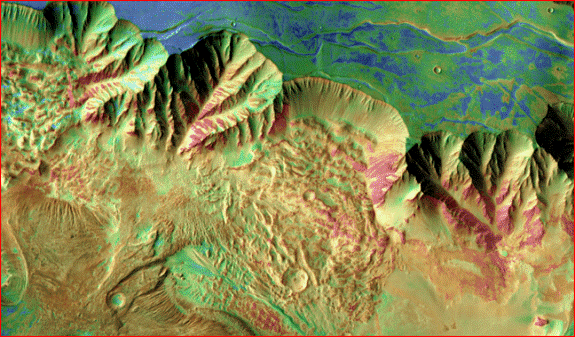
home •
about •
essential guide •
picture of the day •
thunderblogs •
news •
multimedia •
predictions •
products •
get involved •
contact
picture of the day archive subject index
A small section of Candor Chasma, part of the huge trench of Valles Marineris on Mars.
Dec 05, 2006
The Dendritic Ridges of Valles Marineris
Close-up images of Valles Marineris reveal the same dendritic ridge pattern we have observed on Olympus Mons.
NASA spokesmen call it “the most spectacular hole in the ground anywhere.” On Earth, it would stretch from San Francisco to New York. For years, many scientists called it a channel produced by torrential flooding. Then, when higher resolution images removed that possibility, geologists began calling it “the great Martian rift valley.” But if it is a rift, one looks in vain for signs of the stupendous geologic displacement required, not to mention the unresolved issue posed by a body smaller than the earth generating the imagined tectonic forces to create a “rift” hundreds of times larger than the Grand Canyon. Furthermore, a “rift” is typically deeper than it is wide, but Valles Marineris, though up to several miles deep, is vastly wider than deep at its midsection. It’s hard to imagine anyone looking at Valles Marineris and supposing that surface material a few miles deep miraculously spread apart to create a valley up to 370 miles wide!
The picture above is just a small portion of Candor Chasma, a giant alcove of Valles Marineris. Up to this point, we have been unable to find any reference by the THEMIS team to a hugely enigmatic feature—the dendritic ridges that virtually define the scalloped cliffs of the entire region. To gain a sense of the enigma posed, we urge the reader to consider the full image here. And bear in mind that this is not the only portion of Valles Marineris revealing the implausible—or should we say “impossible”—ridge branching.
We have already noted remarkably similar branching patterns both on the “caldera” walls and the steep escarpment of Olympus Mons. It is interesting to note that conventional theory ascribes two completely different geologic processes to Olympus Mons and Valles Marineris. In neither case is a plausible explanation given for the dendritic ridge patterns. Hence the contrast with the predictive ability of the electrical interpretation is inescapable.
In the image above, the color scheme represents the hardness of the surface material. The warm to red colors denote the harder material, while the green and blue represent looser, sandier, or dustier material. So it is significant that the warmest colors (hardest materials) are associated with the ridges. The electric model identifies dendritic ridges as aeolian sedimentary material fused into rock by an electric arc. And for this reason, the unique correspondence to the Lichtenberg figure is key to resolving the mystery.
As a rule, geologists will discuss regions of loose material as sediment laid down by bodies of water, volcanic ash, or landslide debris. But in the electrical interpretation of Martian topography, a new principle is required. On the red planet as a whole, nothing is more apparent than the excavation of material from defined regions, and distributed over large areas as new strata. We can find nothing in any image of Valles Marineris to contradict the electrical hypothesis. And the dendritic ridge pattern stands as a witness to forces not yet even imagined by conventional schools. It requires us to reexamine our assumptions about the origin of similar features on Earth. And it requires that we not simply apply those assumption to features observed on other planets.
It is worth remembering that a cosmic thunderbolt of sufficient power to carve Valles Marineris would not just distribute pulverized debris around the planet, but launch great volumes of rocky and dusty debris into space. This could include both the red dust that has fallen historically upon our own planet and the meteorites that have been definitively identified as Martian in origin. Hence the unexplained dendritic ridges on Valles Marineris and Olympus Mons (and in fact, occurring repeatedly on Mars, as we shall observe in future TPODs) are crucial pointers to a history of the Red Planet far more dramatic than traditional theory has ever allowed.
___________________________________________________________________________Please visit our Forum
The Electric Sky and The Electric Universe available now!

|
|

|
EXECUTIVE EDITORS:
David Talbott, Wallace Thornhill
MANAGING EDITORS:
Steve Smith, Mel Acheson
CONTRIBUTING EDITORS: Dwardu Cardona, Ev Cochrane,
C.J. Ransom, Don Scott, Rens van der Sluijs, Ian Tresman
WEBMASTER: Brian Talbott
Copyright 2006: thunderbolts.info
![]()
home •
thunderblogs •
forum •
picture of the day •
resources •
team •
updates •
contact us

